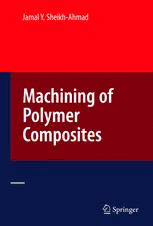
Machining of Polymer Composites PDF
Preview Machining of Polymer Composites
Machining of Polymer Composites Jamal Y. Sheikh-Ahmad Machining of Polymer Composites 123 JamalY.Sheikh-Ahmad ThePetroleumInstitute DepartmentofMechanicalEngineering AbuDhabi UnitedArabEmirates ISBN978-0-387-35539-9 e-ISBN978-0-387-68619-6 DOOOO I:10.1007/978-0-387-68619-6 LibraryofCongressControlNumber:2008932279 (cid:2)c 2009SpringerScience+BusinessMedia,LLC Allrights reserved.Thisworkmaynotbetranslated orcopiedinwholeorinpartwithoutthewritten permissionofthepublisher(SpringerScience+BusinessMedia,LLC,233SpringStreet,NewYork,NY 10013,USA),exceptforbriefexcerptsinconnectionwithreviewsorscholarlyanalysis.Useinconnection withanyformofinformationstorageandretrieval,electronicadaptation,computersoftware,orbysimilar ordissimilarmethodologynowknownorhereafterdevelopedisforbidden. Theuseinthispublicationoftradenames,trademarks,servicemarksandsimilarterms,eveniftheyare notidentifiedassuch,isnottobetakenasanexpressionofopinionastowhetherornottheyaresubject toproprietaryrights. Printedonacid-freepaper 9 8 7 6 5 4 3 2 1 springer.com Thisworkis dedicatedtomy family,who stoodbymy sideallthetime:mywifeManal andmychildrenIman,Sahar,Abdurrahman, andAyah. Preface Theideaforwritingabookonmachiningfiber-reinforcedpolymer(FRP)compos- itescameaboutduringthetimeItaughtagraduatecourseonthesubjectatWichita StateUniversity.Preparinglecturenotesandmaterialforthecoursewasandstillisa laboriousandpainstakingtaskbecauseofthelackofcompletebooksandreferences onthesubject.ThemachiningofFRPcompositesisarelativelynewpractice,and unlike the well-established practicesof metal machining,it is still in the develop- mentstages.Despitethefactthatampleresearchworkhasbeenpublishedinthepast threedecades,thereexistsnosinglesourcethatprovidesacomprehensivetreatment ofthesubjectfromfundamentalandpracticalpointsofview.Therefore,aneedfor suchabookexists,andthiscurrentbookisperhapsthefirstcompilationofitskind onthesubject. This book addresses both the theoretical foundation and practical aspects of machiningFRPcomposites.Abriefintroductiontocompositematerialsisprovided inChap.1.Thisisnecessarytofamiliarizereaderswhoarenewtothesubjectwith theterminology,technology,andmanufacturingaspectsofpolymercomposites.The sectiononpropertiesofcompositesattheendofthischapterisverybriefandbyno meansisafairtreatmentofthisverycomplicatedsubject.Itsinclusionisnecessary for completeness, so that the reader would appreciate the complexity of the sub- ject. Chapter 2 providesa brief synopsis of machining kinematics. This treatment is necessaryfor anyonewhointendsto engagein machiningstudies, whetherit is for metals or composites. Chapter 3 covers the fundamental concept of mechan- ics of chip formation from the experimentaland analytical perspectives. Much of thetechniquesdiscussedinthischapterhavebeenimportedfromestablishedmetal machiningtradition.Acaseinpointistheapplicationofsingleshearplanetheory totheorthogonalmachiningoffiber-reinforcedcomposites.Therefore,greateffort isspentinexplainingthesimilaritiesandcontrastsbetweenmachiningmetalsand composites and the limitations of metal machining theories in this regard. Chap- ter4discussesthephenomenaoftoolwearandprovidesanalysisoftoolmaterials and tool wear mechanisms in machining FRP composites. Once again the differ- encesintoolingrequirementsforcompositesandmetalsmachiningareconsidered. Chapters 5 and 6 discuss the machinability of FRP composites by traditional and vii viii Preface nontraditionalmethods,respectively.Theseincludeturning,milling,drilling,abra- sive,abrasivewaterjet,andlasermachining.Recommendedindustrialpracticesand tips are highlighted whenever possible. Finally, Chap. 7 discusses the important issueofhealthandsafetyinmachiningFRPcomposites.Thischapterfamiliarizes thereaderswiththehealthhazardsinvolvedinmachiningandsomeofthecurrent standardssetbyappropriateauthoritiestodealwiththesehazards. This book should serve as a valuable reference for those engaged in research andformanufacturinganddesign engineerswho areengagedin processselection anddesignofcuttingtoolsformachiningFRPcomposites.Italsoservesasacom- plete and comprehensive textbook for one semester course on the subject at the graduateandupperundergraduatelevelsinmanufacturing,mechanical,ormaterials engineering. ItsmypleasuretoacknowledgemanyofmygraduatestudentsatWichita State University who contributed directly or indirectly to this book. Many of the refer- encesIhaveusedinpreparingtheChaps.3–6werecollectedandreviewedbymy studentsasapartoftheirresearchworkorasarequiredassignmentforthecourseon machiningcomposites.Severalstudents,whosenamesappearinthereferenceslists, haveprovidednecessaryexperimentalresultsincludedinthebook.Myappreciation is also extended to several colleagues from academia and industry who reviewed parts of the manuscriptand providedvaluable feedback.Finally, a special note of thanksisduetomyeditorsSteveElliotandAngelaDePinafortheirindispensable assistanceinpreparingthemanuscript. AbuDhabi,UAE JamalY.Sheikh-Ahmad Contents 1 IntroductiontoPolymerComposites ............................. 1 1.1 DefinitionsandClassification ................................ 2 1.2 AdvantagesandLimitations.................................. 3 1.3 Applications............................................... 5 1.4 ConstituentMaterials ....................................... 7 1.4.1 PolymerMatrices.................................... 8 1.4.2 Reinforcement ...................................... 12 1.4.3 CoreMaterial ....................................... 16 1.5 MaterialFormsandManufacturing............................ 16 1.5.1 ContinuousReinforcementForms ...................... 17 1.5.2 MoldingCompounds................................. 18 1.5.3 PrepregLayupandAutoclaveProcessing ................ 20 1.5.4 FilamentWinding.................................... 21 1.5.5 Pultrusion .......................................... 23 1.5.6 CompressionMolding ................................ 23 1.5.7 LiquidMolding...................................... 24 1.6 PropertiesofComposites .................................... 26 1.6.1 Density ............................................ 26 1.6.2 ElasticProperties .................................... 28 1.6.3 ThermalProperties................................... 29 1.6.4 MultiplyLaminates .................................. 30 1.7 Summary ................................................. 31 ReviewQuestionsandProblems................................... 33 References..................................................... 34 2 ConventionalMachiningOperations ............................. 37 2.1 RequirementsforMachiningFRPs ............................ 38 2.2 Turning................................................... 39 2.3 SinglePointCuttingTools ................................... 41 2.4 MillingandTrimming....................................... 42 2.5 Drilling................................................... 48 ix x Contents 2.6 AbrasiveCutting ........................................... 51 2.7 SurfaceFinish ............................................. 55 2.8 Summary ................................................. 59 ReviewQuestionsandProblems................................... 60 References..................................................... 62 3 MechanicsofChipFormation ................................... 63 3.1 FundamentalConsiderations ................................. 64 3.1.1 OrthogonalMachining................................ 65 3.2 MachiningofPolymers...................................... 71 3.3 MachiningofUnidirectionalFRPS............................ 73 3.3.1 ChipFormationModes ............................... 73 3.3.2 CuttingForces....................................... 81 3.4 MachiningofMultidirectionalLaminates ...................... 89 3.4.1 ChipFormation...................................... 90 3.4.2 CuttingForces....................................... 90 3.5 ModelingoftheChipFormationProcess....................... 91 3.5.1 ShearPlaneModels .................................. 91 3.5.2 MechanicsModelofZhangetal.[20]................... 97 3.5.3 MechanisticModeling................................100 3.6 Summary .................................................104 ReviewQuestionsandProblems...................................106 References.....................................................109 4 ToolMaterialsandToolWear ...................................111 4.1 ToolMaterialsforMachiningFRPs ...........................111 4.1.1 CementedTungstenCarbides ..........................114 4.1.2 CoatedCarbides .....................................115 4.1.3 Ceramics ...........................................116 4.1.4 PolycrystallineDiamond..............................117 4.1.5 PolycrystallineCubicBoronNitride ....................118 4.1.6 DiamondCoatedCarbides.............................118 4.1.7 FutureOutlook ......................................119 4.2 ToolWear.................................................121 4.2.1 TypesofToolWear ..................................122 4.2.2 MeasurementofWear ................................123 4.2.3 ToolWearMechanisms ...............................124 4.2.4 ToolLife ...........................................133 4.3 Summary .................................................137 ReviewQuestionsandProblems...................................138 References.....................................................140 Contents xi 5 ConventionalMachiningofFRPs ................................143 5.1 MachinabilityofFRPs ......................................143 5.2 TurningofFRPs ...........................................145 5.2.1 FiberOrientationinTurning ...........................145 5.2.2 ToolWearinTurningofFRPs .........................146 5.2.3 CuttingForcesandSpecificCuttingEnergy ..............151 5.2.4 CuttingTemperatures.................................154 5.2.5 MachiningQuality ...................................157 5.3 MillingandTrimmingofFRPs ...............................160 5.3.1 FiberOrientationinMillingUnidirectionalFRPs .........161 5.3.2 ToolWear ..........................................162 5.3.3 CuttingForcesandSpecificCuttingEnergy ..............167 5.3.4 MachiningQuality ...................................177 5.3.5 RecommendedPractices ..............................183 5.4 DrillingofFRPs ...........................................187 5.4.1 FiberOrientationinDrilling ...........................188 5.4.2 DrillingThrustForceandTorque.......................189 5.4.3 CuttingTemperatures.................................196 5.4.4 MachiningQuality ...................................197 5.4.5 MechanicsofDelamination............................202 5.4.6 RecommendedPractices ..............................208 5.5 AbrasiveMachiningandGrinding ............................210 5.5.1 AbrasiveMachining..................................211 5.5.2 Grinding ...........................................216 5.6 Summary .................................................226 5.6.1 Turning ............................................227 5.6.2 MillingandTrimming ................................227 5.6.3 Drilling ............................................228 5.6.4 AbrasiveMachiningandGrinding ......................228 ReviewQuestionsandProblems...................................229 References.....................................................232 6 NontraditionalMachiningofFRPs...............................237 6.1 AbrasiveWaterjetMachining.................................237 6.1.1 TechnologyOverview ................................238 6.1.2 MaterialRemovalMechanisms.........................242 6.1.3 AWJMachiningCharacteristicsofFRPS ................246 6.1.4 ModelingofAWJCutting .............................256 6.2 LaserMachining ...........................................260 6.2.1 TechnologyOverview ................................261 6.2.2 MechanismsofMaterialRemoval ......................264 6.2.3 LaserMachiningCharacteristicsofFRPS................265 6.2.4 ModelingandAnalysis ...............................273 6.3 ElectricalDischargeMachining...............................276 6.3.1 TechnologyOverview ................................277 xii Contents 6.3.2 MaterialRemovalMechanisms.........................279 6.3.3 EDMCharacteristicsofFRPS .........................280 6.4 Summary .................................................285 6.4.1 AWJMachining .....................................285 6.4.2 LaserMachining.....................................286 6.4.3 EDM ..............................................287 ReviewQuestionsandProblems...................................287 References.....................................................289 7 HealthandSafetyAspectsinMachiningFRPs ....................293 7.1 HazardSourcesandRoutesofExposure .......................294 7.1.1 MatrixMaterial......................................296 7.1.2 ReinforcementFibers.................................297 7.2 DustGenerationinDryMachining............................298 7.3 AerosolEmissionsinLaserMachining ........................300 7.4 WorkplaceControls.........................................302 7.4.1 AdministrativeControls...............................302 7.4.2 EngineeringControls.................................303 7.4.3 PersonalProtectiveEquipment.........................304 7.4.4 MachineToolHealth .................................304 7.5 Summary .................................................304 References.....................................................306 Index .............................................................309
